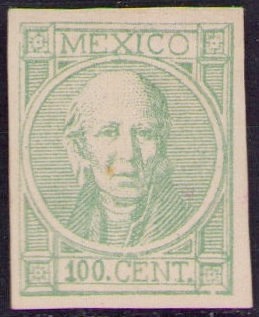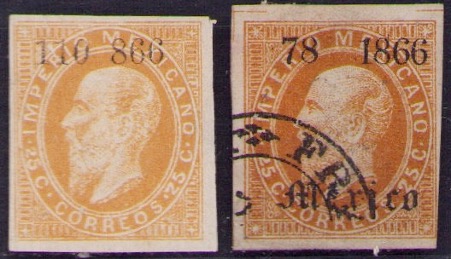
Bubba Bland is the past President of MEPSI, the leading philatelic society for collectors of Mexico. He is also a well-known dealer in classic Mexico stamps and has been selling via eBay for over twenty years.
In the second of this two-part article, we focus on catalogues, proofs and forgeries.
CLA How far will the mainstream catalogues get you?
BB In the classic issues with their district overprints, mainstream catalogues will only show you values for the most common stamps. The values are credible but they lack any form of specialized information.
The catalogue values of mint stamps during the classic period are generally valued higher than used common district issues but this is misleading: classic Mexico is primarily collected used for the district overprints.
Mint examples for that period value about the same regardless of whether they show original gum or no gum. Many earlier mint stamps display damaged gum; mint no gum issues can often be in generally better shape.
Later issue post-1900 stamps are most often collected in mint. Like most countries, the more modern the stamp is, the higher grade of mint never hinged is preferred…but not necessarily required by all collectors.
Used stamps in the classic period are generally far more popular from the scarcer districts and particularly with the fancy and oftentimes colorful cancels.
Generally the catalogue prices are a reasonable benchmark, considering there is not the number of collectors that would elevate the prices to levels seen in the catalogues of say, the US, Europe or British Empire.
CLA What specialist Mexico publications should a collector invest in?
BB Nicholas Follansbee’s catalogue for the classic issues of Mexico is the standard. It is used by all classic collectors of Mexico for stamps issued prior to 1910. The most recent edition was published in 2015.
Overall, Follansbee’s catalogue is still fairly reliable for pricing but bear in mind that it is grading ‘Fine to Very Fine’ whereas Scott is using ‘Very Fine’ as its benchmark. ‘Very Fine’ can be open to interpretation though.
For example, the dos reales from the first issue were printed really close together on the plate. So a stamp with narrow margins that might ordinarily be classified as ‘Fine’ would probably get a ‘Very Fine’ in this instance. The margins were just so small.
Getting more specialized, I would also recommend:
- Schatzkes and Taylor for cancelations from pre-stamp to 1900
- Pietsch for the Eagles issue from the French intervention period
- Stout and Heath for the 1868 issues
- Daffner for the Foreign Mail issues of 1878-83
- Nicholas Follansbee’s dedicated catalogue on the Revolutionary Issues of 1913-1916
Fakes, forgeries and counterfeits

CLA How much of a problem are fakes, forgeries and counterfeits in classic Mexico material? How can a new collector avoid making expensive mistakes?
BB Mexico has been plagued with fakes from the very beginning. Ugly counterfeits were made for the packet trade and reprints were done from original stolen plate material for the first design issues of 1856, 1861 and then the Gothic overprinted issues of 1867-8.
It’s probably the early unofficial reprints that present the new collector with the biggest challenge in separating out the good from the bad. As the reprints were made from the original plates; these can look exactly like the genuine article so it takes a little detective work. But, for many, that can be half the fun.
The complexities of the district overprints can be a little overwhelming to the new collector but the resources are out there to help you. An easy test on the 1856 issues is to look at the paper. If you turn the stamp upside down on a piece of white paper and you can’t see the image through it, then the odds are you have a reprint.
Another simple test, this time on the 1861 issue, is to hold the stamp up to the light and check the grain of the paper. The half, four and six reales values all have a good chance of being genuine if they have a horizontal grain whereas you are looking for a vertical grain on the one and two reales value. You just need to know what you are looking for.
Fake overprints are common in many of the later issues in all areas but especially those of 1899, 1903 and 1910.
The revolutionary period overprints needs care but a copy of Nick Follansbee’s specialized catalogue will prove an invaluable guide. Certainly the local overprints and anything that has been double overprinted or inverted needs extra scrutiny.
However, the good news is that there are many steps that any collector can take in identifying the fakes, from comparing the ugly packet issues to a genuine stamp of the first period design, to learning what to look for in the unofficial fake reprints.
Much information is available in the research material and the MEPSI Expert Committee can always advise on more valuable items. MEPSI has different individuals with specialist knowledge in specific areas; most of what is expertized are either the classic issues or the later, more expensive, material.
As ever, the best advice is to always try and compare a suspect stamp with a similar item that you know to be genuine.
I recently issued a series of newsletters that explains what to look out for when identifying Mexican counterfeits. I can tell by the increase in readership of those newsletters that the subject of identifying fakes is an area with strong collector interest.

All these stamps are genuine but the overprints are false
CLA Proof material is always popular with collectors. Is there much available to the Mexico collector?
BB No, not really. They appear occasionally but there aren’t a lot of proofs available with Mexico, particularly in the classics. For example, on the 1856 issues there was only one proof made: a red trial colour proof (instead of the green) of the dos reales. This would probably have come from just one or two sheets that may have been used for presentation purposes. Any other claimed ‘proofs’ from that issue are not genuine proofs.
There are some proofs available for the twentieth century material but specimen stamps are far more prevalent.
Choosing what to collect
CLA Certain Mexico issues require deep pockets. Where would you recommend a new collector to focus, who wants a relatively inexpensive but interesting area to explore?
BB The saying, “collect what you wish” seem to be the best approach for anyone interested in forming a collection of Mexico. There are a lot of inexpensive options to choose from but bear in mind that almost any area of Mexico will have its more expensive items.
If I were a novice to Mexico, I would start out with simply collecting what I liked. Get familiar with the catalogue and learn the different areas of study. Classic 1856-1883, later classic 1884-1910, Revolutionary War issues (1913-1916), early-modern 1916 to mid-century, modern 1950 to date…these are all great areas to study. And many of these areas can be broken down even further into yet more specialized collecting.
Each era has its individual series that can make great collections. The first two issues of 1856 and 1861 would be very short if you simply stopped at just one example per issue. But if you planned on making it into a speciality with its district overprints, colors and postmarks, it could take a lifetime of work and study.
The other series each have their interesting possibilities. The reference works mentioned earlier can guide you towards developing an outstanding collection.
Whatever you decide to do, from a general collection to a speciality, study what you collect. This will help you achieve the best and most fulfilling collection you can imagine.
Bubba always has a strong selection of well described Mexico stamps for sale on eBay, under the name ‘oobubba’. Also recommended are his regular bulletins, providing advice, guidance and information on all aspects of collecting Mexico. You can subscribe for free by contacting Bubba at oobubba@icloud.com

Leave a Reply